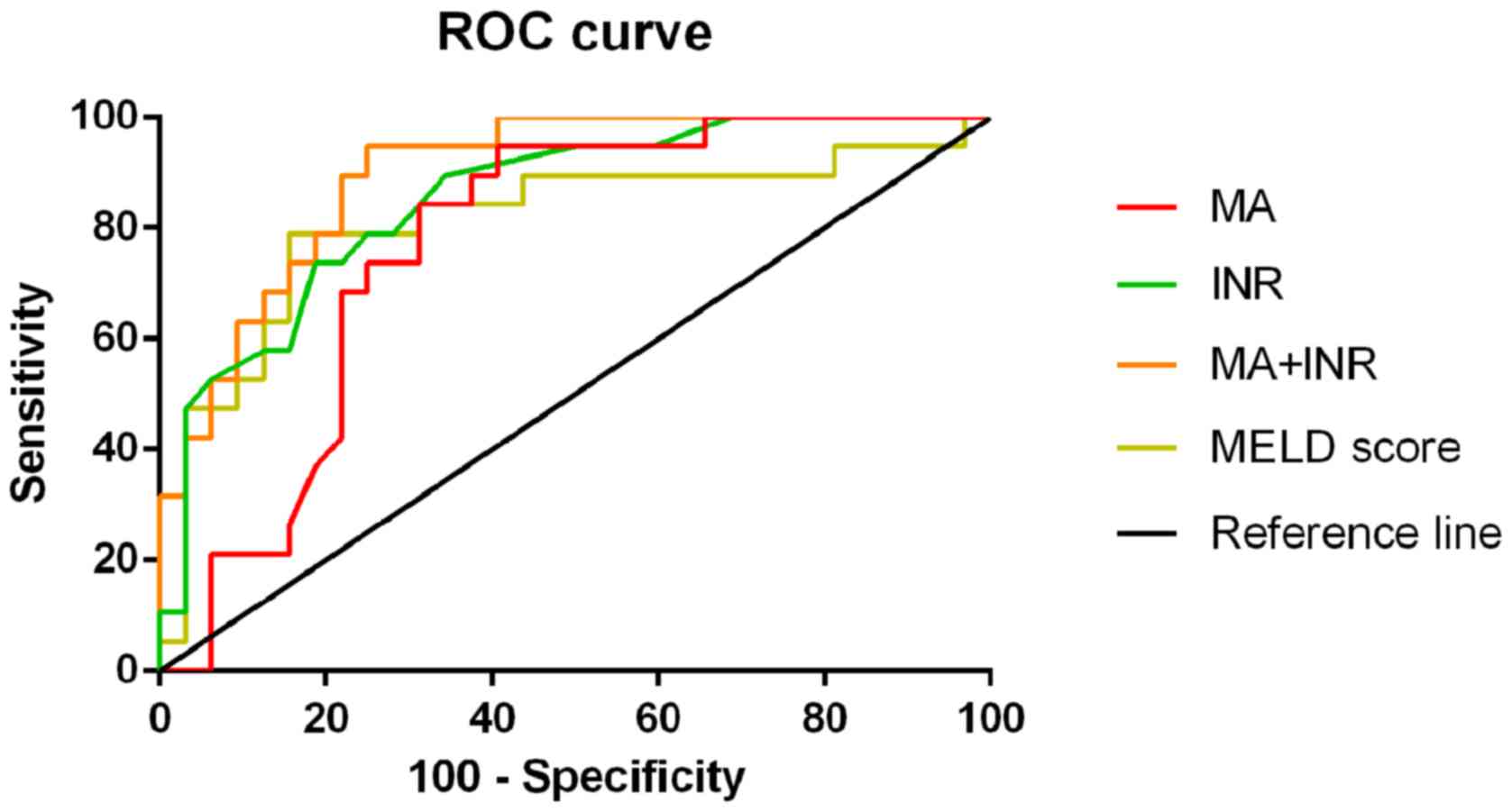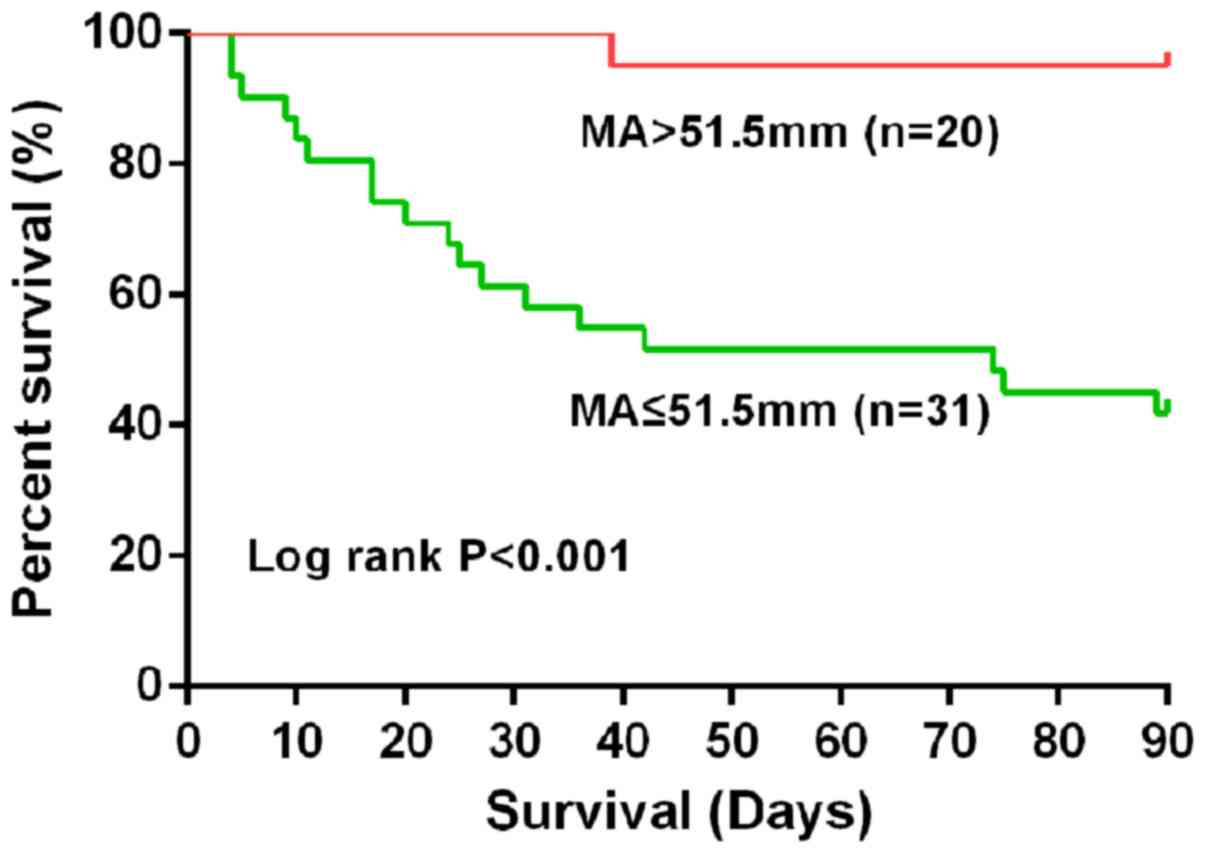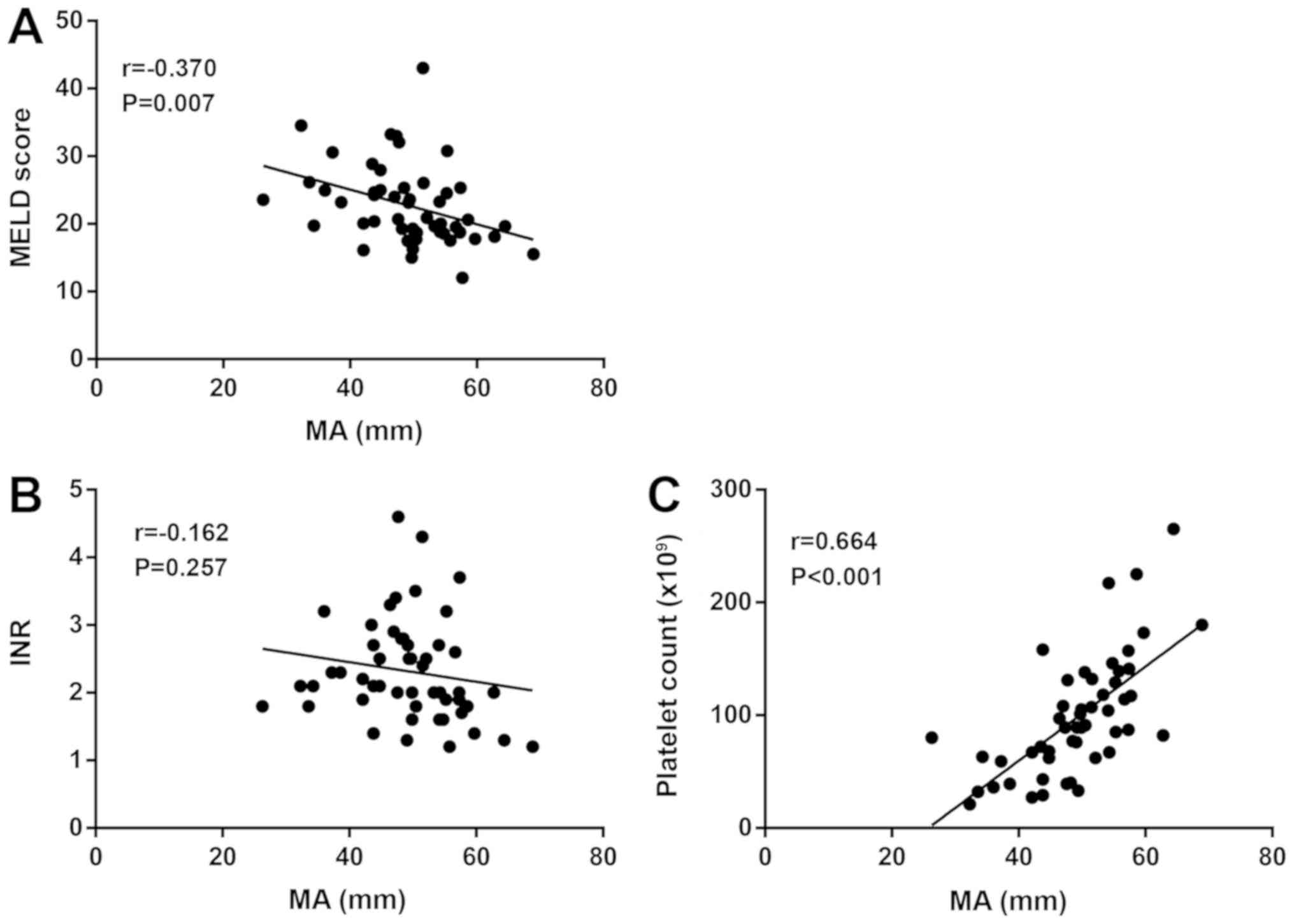|
1
|
Zhao RH, Shi Y, Zhao H, Wu W and Sheng JF:
Acute-on-chronic liver failure in chronic hepatitis B: An update.
Expert Rev Gastroenterol Hepatol. 12:341–350. 2018.PubMed/NCBI View Article : Google Scholar
|
|
2
|
Jalan R, Saliba F, Pavesi M, Amoros A,
Moreau R, Ginès P, Levesque E, Durand F, Angeli P, Caraceni P, et
al: CANONIC study investigators of the EASL-CLIF Consortium:
Development and validation of a prognostic score to predict
mortality in patients with acute-on-chronic liver failure. J
Hepatol. 61:1038–1047. 2014.PubMed/NCBI View Article : Google Scholar
|
|
3
|
Wu T, Li J, Shao L, Xin J, Jiang L, Zhou
Q, Shi D, Jiang J, Sun S, Jin L, et al: Chinese Group on the Study
of Severe Hepatitis B (COSSH): Development of diagnostic criteria
and a prognostic score for hepatitis B virus-related
acute-on-chronic liver failure. Gut. 67:2181–2191. 2018.PubMed/NCBI View Article : Google Scholar
|
|
4
|
Sarin SK, Kedarisetty CK, Abbas Z,
Amarapurkar D, Bihari C, Chan AC, Chawla YK, Dokmeci AK, Garg H,
Ghazinyan H, et al: APASL ACLF Working Party: Acute-on-chronic
liver failure: Consensus recommendations of the Asian Pacific
Association for the Study of the Liver (APASL) 2014. Hepatol Int.
8:453–471. 2014.PubMed/NCBI View Article : Google Scholar
|
|
5
|
Chau TN, Chan YW, Patch D, Tokunaga S,
Greenslade L and Burroughs AK: Thrombelastographic changes and
early rebleeding in cirrhotic patients with variceal bleeding. Gut.
43:267–271. 1998.PubMed/NCBI View Article : Google Scholar
|
|
6
|
Shin KH, Kim IS, Lee HJ, Kim HH, Chang CL,
Hong YM, Yoon KT and Cho M: Thromboelastographic Evaluation of
Coagulation in Patients With Liver Disease. Ann Lab Med.
37:204–212. 2017.PubMed/NCBI View Article : Google Scholar
|
|
7
|
Tripodi A and Mannucci PM: The
coagulopathy of chronic liver disease. N Engl J Med. 365:147–156.
2011.PubMed/NCBI View Article : Google Scholar
|
|
8
|
Hawkins RB, Raymond SL, Hartjes T, Efron
PA, Larson SD, Andreoni KA and Thomas EM: Review: The perioperative
use of thromboelastography for liver transplant patients.
Transplant Proc. 50:3552–3558. 2018.PubMed/NCBI View Article : Google Scholar
|
|
9
|
Wang SC, Shieh JF, Chang KY, Chu YC, Liu
CS, Loong CC, Chan KH, Mandell S and Tsou MY:
Thromboelastography-guided transfusion decreases intraoperative
blood transfusion during orthotopic liver transplantation:
Randomized clinical trial. Transplant Proc. 42:2590–2593.
2010.PubMed/NCBI View Article : Google Scholar
|
|
10
|
De Pietri L, Bianchini M, Montalti R, De
Maria N, Di Maira T, Begliomini B, Gerunda GE, di Benedetto F,
Garcia-Tsao G and Villa E: Thrombelastography-guided blood product
use before invasive procedures in cirrhosis with severe
coagulopathy: A randomized, controlled trial. Hepatology.
63:566–573. 2016.PubMed/NCBI View Article : Google Scholar
|
|
11
|
Trautman CL, Palmer WC, Taner CB, Canabal
JM, Getz T, Goldman A, Heckman MG, Diehl NN, Lee DD and
Stancampiano FF: Thromboelastography as a Predictor of Outcomes
Following Liver Transplantation. Transplant Proc. 49:2110–2116.
2017.PubMed/NCBI View Article : Google Scholar
|
|
12
|
Premkumar M, Saxena P, Rangegowda D,
Baweja S, Mirza R, Jain P, Bhatia P, Kumar G, Bihari C, Kalal C, et
al: Coagulation failure is associated with bleeding events and
clinical outcome during systemic inflammatory response and sepsis
in acute-on-chronic liver failure: An observational cohort study.
Liver Int. 39:694–704. 2019.PubMed/NCBI View Article : Google Scholar
|
|
13
|
Blasi A, Calvo A, Prado V, Reverter E,
Reverter JC, Hernández-Tejero M, Aziz F, Amoros A, Cardenas A and
Fernández J: Coagulation failure in patients with acute-on-chronic
liver failure and decompensated cirrhosis: Beyond the international
normalized ratio. Hepatology. 68:2325–2337. 2018.PubMed/NCBI View Article : Google Scholar
|
|
14
|
Shi Y, Yang Y, Hu Y, Wu W, Yang Q, Zheng
M, Zhang S, Xu Z, Wu Y, Yan H, et al: Acute-on-chronic liver
failure precipitated by hepatic injury is distinct from that
precipitated by extrahepatic insults. Hepatology. 62:232–242.
2015.PubMed/NCBI View Article : Google Scholar
|
|
15
|
Lin W, Zhang J, Liu X, Liu H, He J, Li M,
Zhang S, Zhang Y, Chen H, Zhang C, et al: A Dynamic model for
predicting outcome in patients with HBV related acute-on-chronic
liver failure. Ann Hepatol. 17:392–402. 2018.PubMed/NCBI View Article : Google Scholar
|
|
16
|
Peng Y, Qi X, Tang S, Deng H, Li J, Ning
Z, Dai J, Hou F, Zhao J, Wang R, et al: Child-Pugh, MELD, and ALBI
scores for predicting the in-hospital mortality in cirrhotic
patients with acute-on-chronic liver failure. Expert Rev
Gastroenterol Hepatol. 10:971–980. 2016.PubMed/NCBI View Article : Google Scholar
|
|
17
|
Stravitz RT: Potential applications of
thromboelastography in patients with acute and chronic liver
disease. Gastroenterol Hepatol (NY). 8:513–520. 2012.PubMed/NCBI
|
|
18
|
Reikvam H, Steien E, Hauge B, Liseth K,
Hagen KG, Størkson R and Hervig T: Thrombelastography. Transfus
Apheresis Sci. 40:119–123. 2009.PubMed/NCBI View Article : Google Scholar
|
|
19
|
Fisher C, Patel VC, Stoy SH, Singanayagam
A, Adelmeijer J, Wendon J, Shawcross DL, Lisman T and Bernal W:
Balanced haemostasis with both hypo- and hyper-coagulable features
in critically ill patients with acute-on-chronic-liver failure. J
Crit Care. 43:54–60. 2018.PubMed/NCBI View Article : Google Scholar
|
|
20
|
Lloyd-Donald P, Vasudevan A, Angus P, Gow
P, Mårtensson J, Glassford N, Eastwood GM, Hart GK and Bellomo R:
Coagulation in acutely ill patients with severe chronic liver
disease: Insights from thromboelastography. J Crit Care.
38:215–224. 2017.PubMed/NCBI View Article : Google Scholar
|
|
21
|
Goyal S, Jadaun S, Kedia S, Kumar-Acharya
S, Varma S, Nayak B, Thakur B and M D S: Thromboelastography
Parameters in Patients with Acute on Chronic Liver Failure. Ann
Hepatol. 17:1042–1051. 2018.PubMed/NCBI View Article : Google Scholar
|
|
22
|
Dai J, Qi X, Li H and Guo X: Role of
D-dimer in the development of portal vein thrombosis in liver
cirrhosis: A meta-analysis. Saudi J Gastroenterol. 21:165–174.
2015.PubMed/NCBI View Article : Google Scholar
|
|
23
|
Li Y, Qi X, Li H, Dai J, Deng H, Li J,
Peng Y, Liu X, Sun X and Guo X: D-dimer level for predicting the
in-hospital mortality in liver cirrhosis: A retrospective study.
Exp Ther Med. 13:285–289. 2017.PubMed/NCBI View Article : Google Scholar
|
|
24
|
Lisman T, Bakhtiari K, Adelmeijer J,
Meijers JC, Porte RJ and Stravitz RT: Intact thrombin generation
and decreased fibrinolytic capacity in patients with acute liver
injury or acute liver failure. J Thromb Haemost. 10:1312–1319.
2012.PubMed/NCBI View Article : Google Scholar
|
|
25
|
Leebeek FW and Rijken DC: The fibrinolytic
status in liver diseases. Semin Thromb Hemost. 41:474–480.
2015.PubMed/NCBI View Article : Google Scholar
|
|
26
|
Stravitz RT, Ellerbe C, Durkalski V,
Reuben A, Lisman T and Lee WM: Acute Liver Failure Study G.
Thrombocytopenia is associated with multi organ system failure in
patients with acute liver failure. Clin Gastroenterol Hepatol.
14:613–620 e614. 2016.PubMed/NCBI View Article : Google Scholar
|
|
27
|
Beilin Y, Arnold I and Hossain S:
Evaluation of the platelet function analyzer (PFA-100) vs. the
thromboelastogram (TEG) in the parturient. Int J Obstet Anesth.
15:7–12. 2006.PubMed/NCBI View Article : Google Scholar
|
|
28
|
Vinholt PJ, Hvas AM, Nielsen C, Söderström
AC, Sprogøe U, Fialla AD and Nybo M: Reduced platelet activation
and platelet aggregation in patients with alcoholic liver
cirrhosis. Platelets. 29:520–527. 2018.PubMed/NCBI View Article : Google Scholar
|
|
29
|
Shi X, Zhu P, Yan G, Liu C, Zhang C, Huang
G, Zhang Y, Yan Z and Wang Y: Clinical characteristics and
long-term outcome of acute kidney injury in patients with
HBV-related acute-on-chronic liver failure. J Viral Hepat.
23:920–929. 2016.PubMed/NCBI View Article : Google Scholar
|
|
30
|
Lisman T and Luyendyk JP: Platelets as
modulators of liver diseases. Semin Thromb Hemost. 44:114–125.
2018.PubMed/NCBI View Article : Google Scholar
|
|
31
|
Li N, Huang C, Yu KK, Lu Q, Shi GF and
Zheng JM: Validation of prognostic scores to predict short-term
mortality in patients with HBV-related acute-on-chronic liver
failure: The CLIF-C OF is superior to MELD, CLIF SOFA, and CLIF-C
ACLF. Medicine (Baltimore). 96(e6802)2017.PubMed/NCBI View Article : Google Scholar
|

















